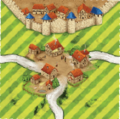Les Paysans
Informations générales et commentaires
Produit originellement par Hans im Glück en 2014.
Les paysans sont considéré comme faisant partie du jeu de base par la plupart des joueurs de Carcassonne. Ils sont également utilisé dans tous les tournois officiels puisque qu'ils ne sont pas considéré comme une extension. Dans la nouvelle édition de Carcassonne les paysans ont été séparés pour faciliter l'approche du jeu pour les nouveaux joueurs. WikiCarpedia suit cette approche simplifiée. Pour les autres extensions et le reste de WikiCarpedia, les paysans sont considérés comme faisant partie du jeu de base.
Que serait la vie sans l'agriculture ? Nous essayons de répondre en partie à cette question en présentant les paysans qui travaillent dur et passent de longues heures dans les prés de Carcassonne. Comme nous l'avons fait pour les routes, les villes et les monastères, les fermiers seront présentés en utilisant les actions d'un tour de jeu.
Matériel
- Aucun. Seul le matériel du jeu de base est utilisé.
Règles
Placement d'une tuile Pré
Comme d'habitude, piochez tout d'abord une tuile et placez-la afin de prolonger les zones existantes. Le terme "pré" désigne chaque espace vert de Carcassonne.[1]
Placing a meeple as a farmer
A farmer is a meeple that you place “laying down” in a field segment. Unlike highwaymen, knights, and monks that are all placed standing up, farmers are laid down on a tile because they are only scored at the end of the game. Consequently, they are not returned to your supply after scoring[2]. Laying farmers down ensures that you remember to leave them on the board. As always, you can only place your farmer if there are no other farmers in the field. The fields of Carcassonne are divided by roads and cities. Pictured below are three separate fields.
Scoring fields
As mentioned previously, farmers are not scored during the game and, consequently, they do not return to your supply. So place your farmers wisely. Now, let’s assume the game is over and that we are conducting the final scoring. Unlike other features, it is not the field tiles that are counted, but the number of completed cities that border a field. Each completed city that touches a field adds 3 points to the value of that field. All fields touched by a city will see their value increased by 3 points[3][4].

Summary
A brief summary the most important details about farmers:
- Farmers are placed “laying down” on the board.
- Farmers are only scored during the final scoring, not during the game.
- Each completed city adjacent to a field you occupy gives you 3 points.
- Each completed city can be worth points for any number of different fields.
- Similar to roads and cities, if there is more than one farmer in the same field, only the player with the most farmers in that field scores its points. In the case of a tie, each tied player scores full points.
Footnotes
For Icons explanation and licensing please visit Icons page.
- ↑
 Pour déterminer la taille des prés, les prés peuvent être délimités par toute sorte de barrière, par exemple, les routes, les villes, ou les rivières qui ne peuvent pas être contournés, ou encore le bord du terrain de jeu. Cela peut certainement arrivé quand un pré couvre la quasi totalité du terrain de jeu, et il y aura certainement des prés qui resteront ouvert toute la partie.
Pour déterminer la taille des prés, les prés peuvent être délimités par toute sorte de barrière, par exemple, les routes, les villes, ou les rivières qui ne peuvent pas être contournés, ou encore le bord du terrain de jeu. Cela peut certainement arrivé quand un pré couvre la quasi totalité du terrain de jeu, et il y aura certainement des prés qui resteront ouvert toute la partie.
- ↑
 In reality, some special mechanics in some expansions (The Festival, the Dragon, etc.) do allow return of farmers to their owners. (12/2014)
In reality, some special mechanics in some expansions (The Festival, the Dragon, etc.) do allow return of farmers to their owners. (12/2014)
- ↑
 Question: It is unclear whether incomplete farms earn points during the final scoring. Answer: It is almost impossible to close off or complete most of the farms. The most important thing when scoring the farms are the cities, which do indeed have to be complete. So: completed cities count on incomplete farms as well.
Question: It is unclear whether incomplete farms earn points during the final scoring. Answer: It is almost impossible to close off or complete most of the farms. The most important thing when scoring the farms are the cities, which do indeed have to be complete. So: completed cities count on incomplete farms as well.
- ↑
 Question: At the end of the game, do we score farms which are completely closed off by roads, but which don't have any adjacent cities? If so, how? Answer: Strictly speaking, they should be scored exactly like every other farm, with 3 points for every completed city. In this case, that makes a total of zero points. And the farmer is nevertheless unable to leave the farm.
Question: At the end of the game, do we score farms which are completely closed off by roads, but which don't have any adjacent cities? If so, how? Answer: Strictly speaking, they should be scored exactly like every other farm, with 3 points for every completed city. In this case, that makes a total of zero points. And the farmer is nevertheless unable to leave the farm.

